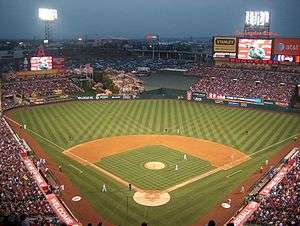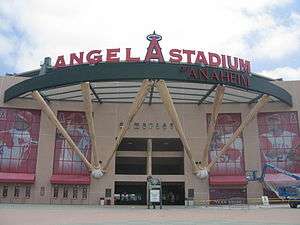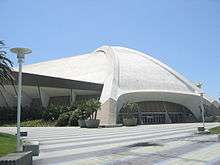Angel Stadium
| The Big A[1] | |
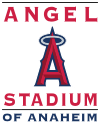 | |
|
Angel Stadium in 2009 | |
| Former names |
Anaheim Stadium (1966–1997) Edison International Field of Anaheim (1998–2003) |
|---|---|
| Address | 2000 Gene Autry Way |
| Location | Anaheim, California |
| Coordinates | 33°48′1″N 117°52′58″W / 33.80028°N 117.88278°WCoordinates: 33°48′1″N 117°52′58″W / 33.80028°N 117.88278°W |
| Public transit |
Anaheim Resort Transit ARTIC (Anaheim Regional Transportation Intermodal Center) |
| Owner | City of Anaheim |
| Operator | Angels Baseball LP |
| Capacity |
43,250 (1966) 64,593 (Baseball—1980) 69,008 (Football—1980) 45,957 (2015) |
| Field size |
Left Field – 347 ft (105.8 m) Left-Center – 390 ft (118.9 m) Center Field – 396ft (120.7 m) Right-Center – 370 ft (112.8 m) Right-Center (shallow) – 365 ft (111.3 m) Right Field – 350ft (106.7 m) Backstop – 60.5 ft (18.4 m) |
| Surface | Tifway 419 Bermuda Grass |
| Construction | |
| Broke ground | August 31, 1964 |
| Opened |
April 19, 1966[2] April 1, 1998 (renovations) |
| Construction cost |
US$24 million ($175 million in 2016 dollars[3]) $118 million (1997–1999 renovations) ($172 million in 2016 dollars[3]) |
| Architect |
Noble W. Herzberg and Associates (1966)[4] Populous Robert A. M. Stern, and Walt Disney Imagineering (Renovations) |
| General contractor |
Del E. Webb Company (1966) Turner Construction Company (Renovations)[5] |
| Tenants | |
|
Los Angeles Angels of Anaheim (MLB) (1966–present) Orange County Ramblers (CoFL) (1967–1968) Southern California Sun (WFL) (1974–1975) California Surf (NASL) (1978–1981) Los Angeles Rams (NFL) (1980–1994) Freedom Bowl (NCAA) (1984–1994) | |
Angel Stadium of Anaheim, originally known as Anaheim Stadium and later Edison International Field of Anaheim, is a modern-style ballpark located in Anaheim, California. Since its opening in 1966, it has served as the home ballpark of the Los Angeles Angels of Anaheim of Major League Baseball (MLB), and was also the home stadium to the Los Angeles Rams of the National Football League (NFL) from 1980 to 1994. The stadium is often referred to by its unofficial nickname The Big A. It is the fourth-oldest active Major League Baseball stadium, behind Fenway Park, Wrigley Field, and Dodger Stadium.[6] It hosted the 1967, 1989, and 2010 Major League Baseball All-Star Games.[7]
Angel Stadium and its surrounding parking lot are roughly bounded by Katella Avenue to the north, the Orange Freeway to the east, Orangewood Avenue to the south, and State College Boulevard to the west. Located near the eastern boundary of the parking lot is the landmark "Big A" sign and electronic marquee, which originally served as a scoreboard support. The halo located near the top of the 230' tall, 210-ton sign is illuminated following games in which the Angels win (both at home and on the road), which gives rise to the fan expression, "Light up the Halo!"
ARTIC (Anaheim Regional Transportation Intermodal Center) servicing the Metrolink Orange County Line and Amtrak Pacific Surfliner, is located nearby on the other side of the State Route 57 and accessed through the Douglass Road gate at the northeast corner of the parking lot. The station provides convenient access to the stadium, the nearby Honda Center, and Disneyland from various communities along the route, which links San Luis Obispo, Los Angeles, and San Diego. The Anaheim Resort Transit stops at the center along with Orange County Transportation Authority buses.
Aside from professional baseball and football, Angel Stadium has hosted high school and college football games, National Football League pre-season games, the short-lived World Football League, two crusades by evangelist Billy Graham, nearly 20 consecutive annual crusades by evangelist Greg Laurie and musical concerts featuring such acts as The Rolling Stones,[8] The Who,[9] Pink Floyd,[9] The Grateful Dead and Madonna.
The stadium also houses the studios and offices of the Angels' owned and operated flagship radio station, KLAA (830 AM).
History
Beginnings

Angel Stadium has been the home of the Angels since their move from Los Angeles. On August 31, 1964, ground was broken for Anaheim Stadium and in 1966, the then-California Angels moved into their new home after having spent four seasons renting Dodger Stadium (referred to in Angels games as Chávez Ravine Stadium) from the Dodgers.
The stadium was built on a parcel of about 160 acres (0.65 km2) of flat land originally used for agricultural purposes by the Allec, Russell, and Knutzen families[1] in the southeast portion of Anaheim. Consistent with many major-league sports stadiums built in the 1960s, it is located in a suburban area, though one that is host to major tourist attractions.
The field dimensions (333 feet instead of 347 or 350, for example) were derived from a scientific study conducted by the Angels. Based on the air density at normal game times (1:30 pm and 8 pm), the Angels tried to formulate dimensions that were fairly balanced between pitcher, hitter and average weather conditions. The Angels tinkered with those dimensions several times, expanding or contracting parts of the outfield by a few feet here and there, to try to refine that balance.
None of this seemed to matter to their Hall of Fame pitcher Nolan Ryan, who threw two of his record seven no-hitters in this ballpark, and racked up 2,416 of his 5,714 career strikeouts in eight seasons with the Angels (Ryan stats from The Sporting News Baseball Record Book). One of the no-hitters, on June 1, 1975, was his fourth, which tied Sandy Koufax's career record, one Ryan would eventually supplant.
The Rams move in

In the late 1970s, Los Angeles Rams owner Carroll Rosenbloom was looking for a more modern venue than the Los Angeles Memorial Coliseum, and also wanted a stadium that would be small enough to keep Rams games from being blacked out on local television. The Coliseum seated almost 100,000 people, and the Rams had trouble filling it even in their best years. Rosenbloom brokered a deal by which the Rams would move from Los Angeles to an expanded Anaheim Stadium. To add more seats (eventually about 23,000) for football games, the mezzanine and upper decks were extended completely around the playing field, resulting in a roughly trapezoidal, completely enclosed stadium. An elevated bank of bleachers was built in right field, and temporary seats were placed underneath, to be pulled out for football games. Another bank of bleachers was built in left field. As a result, the view of the local mountains and State Highway 57 was lost.
Additionally, the Big A scoreboard support that stood in left field and was the inspiration for the stadium's nickname was moved 1,300 feet (400 m) to its present site in the parking lot, adjoining the Orange Freeway beyond the right-field stands; its usage changed from scoreboard to electronic marquee advertising upcoming events at the stadium. A black and white scoreboard/instant replay video board was installed above the newly constructed upper deck seats in left field, but was later deemed inadequate, especially during day games (in 1988 the scoreboard was replaced by a Sony Jumbotron color video board, with black and white matrix scoreboards installed above the right field upper deck and the infield upper deck). A triangular metal spire was added to the top of the Jumbotron to evoke the original emplacement of the "Big A".
The changes did not sit well with Angels fans. As originally built, no seat was further than 109 feet from the field.[10] However, as was the case nearly everywhere else where the multipurpose stadium concept was tried, most of the new center field seats were too far from the action. Also, while the expanded capacity allowed the Angels to set attendance records that still stand today, on most occasions even crowds of 40,000 were swallowed up by the environment.
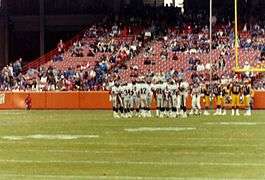
The expansion was completed in time for the 1980 NFL season, and the Rams played in Anaheim Stadium from then until their move to St. Louis after the 1994 season.
The January 17, 1994 Northridge earthquake caused the Sony Jumbotron to collapse onto the upper deck seats beneath it. No injuries were caused, as the stadium was unoccupied when the earthquake occurred in the predawn hours of a national holiday (Martin Luther King, Jr. Day). The damaged section was deconstructed and rebuilt with a new scoreboard structure and Jumbotron, eliminating A-frame spire that evoked the Big A.[11]
The Disney era
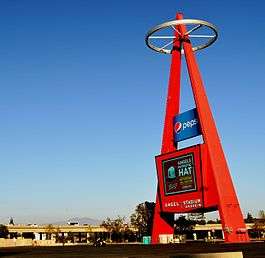
In 1996, The Walt Disney Company, a minority owner of the team since its inception (the stadium is located less than 3 miles (5 km) east of Disneyland and across from the Honda Center, the home venue of the then Disney-owned Mighty Ducks of Anaheim), gained enough support on the board to effectively take control of the team. Soon afterward, the Angels and the city of Anaheim agreed to a new deal that would keep the Angels in Anaheim until 2031, with an option to leave the facility after the 2016 season. As part of the deal, the stadium underwent an extensive renovation, returning the stadium to its original role as a baseball-only facility. Before the 1997 baseball season, the section behind the outfield wall was demolished. Disney briefly considered moving the Big A scoreboard to its original location, but decided against such a move, citing costs, as well as the fact that the Big A had become a Southern California landmark in its parking lot location.
Despite the fact that much of the stadium was still a hard-hat zone, the demolition and construction being only half-completed, the Angels played their 1997 season in Anaheim. Fans were greeted by a restored view of the San Gabriel and Santa Ana Mountains, the Brea Hills, and the 57 freeway beyond the outfield.
Work that didn't interfere with game play continued throughout the 1997 season, with major renovations resuming in the winter of 1997. These included the installation of outfield bleacher pavilions, a video display board and an out-of-town scoreboard below the right field seats. All of the multicolored seats were replaced by green seats. The exterior of the stadium was also renovated. The concrete structure and ramps were painted a combination of green and sandstone. Much of the facade of the stadium was torn down to create a more open feeling for visitors.
The most notable feature of the entire renovation, however, was a "California Spectacular" in which geysers erupt and a stream cascades down a mountainside (Pride Rock) covered with real trees, artificial rocks behind the left-center field fence, and new bullpens. Fireworks shoot out of the display at the start of games, after every Angel home run and after every Angel win (they had been shot off from a parking garage before then).
The field dimensions of the renovated stadium became somewhat asymmetrical, with the 8-foot (2.4 m) high fence in right center field (which earlier hid the football-only bleacher section) replaced by a 19-foot (5.8 m) high wall which contains a scoreboard displaying out-of-town scores of other games. A plaza was built around the perimeter of the stadium, and inside are statues depicting longtime Angel owner and chairman Gene Autry and Michelle Carew, daughter of former Angel Rod Carew, who died of leukemia at the age of 18.

The main entrance includes two giant Angels hats complete with New Era tags on the sweatband (including one indicating the hats' size: 649½). The hats were originally blue and featured the Angels' "winged" logo designed by Disney for the 1997 season, and were repainted red and decorated with the present-day halo insignia for the 2002 season. Also outside home plate gate is a full-sized brick infield complete with regulation pitcher's mound and lighted bases, with bricks at each player position engraved with the names of Angels players who played at that position on Opening Day of each season since the Angels joined the American League in 1961. For a fee, the green infield bricks can be engraved with fans' names or personalized messages. The Angels opened their "new" stadium on April 1, 1998 with a 4–1 victory over the New York Yankees.[12] The renovated stadium has 5,075 club seats and 78 luxury suites.
In 1998, the stadium was renamed Edison International Field of Anaheim after local utility Edison International reached a deal giving it naming rights over the stadium for 20 years, and during this time, the stadium was referred to as the Big Ed. However, after the 2003 season, Edison International exercised its option to exit the sponsorship deal. On December 29, 2003, the Angels announced that from then on the stadium would be known as Angel Stadium (in full, Angel Stadium of Anaheim). Some locals can still be caught calling the venue by its original name, Anaheim Stadium, as well. After the name change in 2004, its original nickname, The Big A, was restored again. Despite efforts to cover them up with the Angels' halo insignia, Edison's insignia can still be found on the ends of seating rows throughout the ballpark.
In 2009, Brookings, South Dakota-based Daktronics installed light emitting diode (LED) displays at the stadium. The largest video display measures 41 feet high by 67 feet wide. Two smaller displays flank the large display, and a field-level display sits in the centerfield fence.[13]
Seating capacity
Baseball
- 43,202 (1966–1978)
- 43,250 (1979)
- 65,158 (1980–1985)
- 64,573 (1986–1987)
- 64,593 (1988–1996)
- 33,851 (1997)
- 45,050 (1998–2005)
- 45,262 (2006–2007)
- 45,281 (2008–2009)
- 45,389 (2010–2011)
- 45,957 (2012)
- 45,483 (2013–2014)
- 45,957 (2015–present)
Football
- 69,008 (1980–1994)
Notable events
Baseball

The stadium was host to the 1967 MLB All-Star Game, the first All-Star Game to be played on prime-time television although two All-Star Games were played at night during World War II, and again in 1989 and 2010.[7]
It hosted seven American League Division Series (2002, 2004, 2005, 2007, 2008, 2009, and 2014) and six American League Championship Series (1979, 1982, 1986, 2002, 2005, and 2009). Most notably, it hosted the 2002 World Series, which the Angels won in dramatic fashion over the San Francisco Giants, finally winning one for their late and long-time owner, "Singing Cowboy" Gene Autry (and for his widow and business partner Jackie, who is also honorary president of the American League).
Angel Stadium hosted several games during Round 2 of the 2006 World Baseball Classic.
Famous individual baseball milestones attained here include Mickey Mantle's last game-winning home run, Nolan Ryan's striking out of nine straight Boston Red Sox, Reggie Jackson's 500th career home run, Rod Carew's 3,000th career base hit, Vladimir Guerrero's 400th career home run, and George Brett's 3,000th career base hit.
On Saturday, August 9, 2014, the stadium hosted its longest game ever: a 6-hour, 31-minute contest between the Angels and the Boston Red Sox. Albert Pujols led off the batting in the bottom of the 19th inning with a walk-off homer, giving the Angels the win, 5-4.[14]
Motion picture set
Several major motion pictures have been shot at Angel Stadium. The final sequence of The Naked Gun: From the Files of Police Squad! (1988) features an electronically manipulated Reggie Jackson trying to shoot Queen Elizabeth II. Exteriors were shot at the ballpark, but most baseball scenes were shot at Dodger Stadium. The 1990 comedy Taking Care of Business featured a World Series matchup between the Angels and the Chicago Cubs, with the baseball scenes in the movie having been filmed in the stadium. The Disney remake of Angels in the Outfield (1994) prominently uses the ballpark; however, many of the interior shots were filmed at the Oakland Alameda Coliseum. The stadium served as a stand-in for Candlestick Park in filming of The Fan (1996). Scenes from Deuce Bigalow: Male Gigolo, and Air Bud: Seventh Inning Fetch.
Other events
On November 16, 1979, Anaheim Stadium hosted Motorcycle speedway when it was the venue for the American Final, a qualifying round for the 1980 Speedway World Championship. Future dual World Champion Bruce Penhall won the Final from Scott Autrey and Dennis Sigalos. Penhall and Autrey qualified to the Intercontinental Final in England held over 6 months later. Penhall qualified through to his first World Final held at the Ullevi Stadium in Gothenburg, Sweden where he finished in 5th place.
Anaheim Stadium has hosted an AMA Supercross Championship round from 1976 to 1979, 1981 to 1987, 1989 to 1996, and 1999 to the present.[15]
Angel Stadium has been the site of annual Harvest Crusades since 1990.[16] U2 has performed at the stadium three times: on November 14, 1992 during their Zoo TV Tour, and on June 17 and 18, 2011, during their U2 360° Tour. In 2014, Barack Obama spoke at the commencement ceremony for the University of California, Irvine, which was held at the stadium to accommodate capacity and security concerns.
The Stadium was featured in a 2014 episode of the CBS series The Big Bang Theory, where one of the main characters, Howard, was asked to throw out the first pitch for Space Day.
References
- 1 2 Weyler, John. "20TH ANNIVERSARY . . . : THE BIG A : A Place Where Billy Graham, Rockers and Angels Have Tread". Los Angeles Times. Retrieved 26 October 2012.
- ↑ http://www.worldofstadiums.com/north-america/united-states/california/angel-stadium-of-anaheim/
- 1 2 Federal Reserve Bank of Minneapolis Community Development Project. "Consumer Price Index (estimate) 1800–". Federal Reserve Bank of Minneapolis. Retrieved October 21, 2016.
- ↑ Angel Stadium - history, photos and more of the Los Angeles Angels ballpark
- ↑ Ballparks by Munsey and Suppes
- ↑ Shaikin, Bill. (2013-08-30) 'Los Angeles Angels of Anaheim' could be no more. latimes.com. Retrieved on 2013-09-06.
- 1 2 MLB.com
- ↑ Tully, Sarah (November 18, 2005). "The Catch to close for at least a year". The Orange County Register. Retrieved 10 October 2010.
- 1 2 Townsend, Adam (December 2, 2008). "Thom leaves a legacy of rock 'n' roll and Latino rights". The Orange County Register. Retrieved 10 October 2010.
- ↑ Smith, Curt (2001). Storied Stadiums. New York City: Carroll & Graf. ISBN 0-7867-1187-6.
- ↑ Busser, Bob. "Anaheim Stadium part 2 – Anaheim, California". Ballparks, Arenas and Stadiums. Retrieved 11 May 2015.
- ↑ 1998 Anaheim Angels Schedule by Baseball Almanac
- ↑ "Daktronics Photo Gallery: Angel Stadium of Anaheim".
- ↑ Edes, Gordon (10 August 2014). "Rapid reaction: Angels 5, Red Sox 4". ESPN. Retrieved 10 August 2014.
- ↑ 2015 AMA Supercross media guide
- ↑ http://www.ocregister.com/articles/laurie-greg-harvest-2522890-crusade-people
External links
| Wikimedia Commons has media related to Angel Stadium of Anaheim. |
- Stadium site on angels.com
- Angel Stadium at ballparksofbaseball.com
- Ballpark Digest Visit to Angel Stadium
- Angel Stadium's Major Renovations
- MLB's Ballpark History
- Angel Stadium Seating Chart
